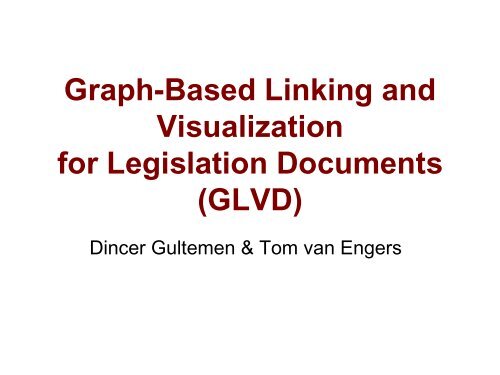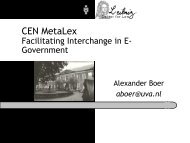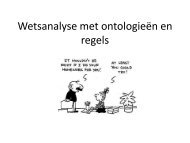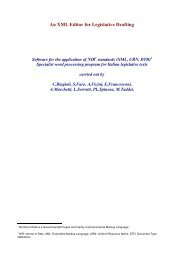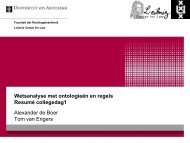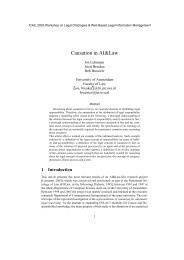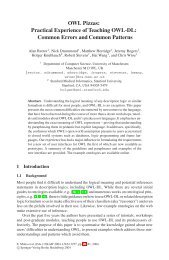Graph-Based Linking and Visualization for Legislation Documents ...
Graph-Based Linking and Visualization for Legislation Documents ...
Graph-Based Linking and Visualization for Legislation Documents ...
You also want an ePaper? Increase the reach of your titles
YUMPU automatically turns print PDFs into web optimized ePapers that Google loves.
<strong>Graph</strong>-<strong>Based</strong> <strong>Linking</strong> <strong>and</strong><strong>Visualization</strong><strong>for</strong> <strong>Legislation</strong> <strong>Documents</strong>(GLVD)Dincer Gultemen & Tom van Engers
Dem<strong>and</strong> of Parliaments• Semi-structured in<strong>for</strong>mation <strong>and</strong> semantictechnologies– Inter-institutional business process reductionthrough interoperability• Parliament as harmonizer-hub <strong>for</strong> the orchestrationof inter-institutional law-making process– Legal analysis <strong>and</strong> consistency verification <strong>for</strong>complexly interlinked regulatory interactions• ? More granular <strong>and</strong> composite networkconstruction• ? Multi-layer semantic network verification-analysis
Sources of Law <strong>and</strong> SNL Model• More granular <strong>and</strong> composite networkconstruction– Semantically enriched documents– The interactions between documents representingsources-of-law = source-network-of-law (SNL)• <strong>Legislation</strong> (statutory law) level network– Conceptual graph <strong>for</strong>mation with increased nodegranularity at the paragraph-article level– Verification of SNL = Network Approach + SemanticTechnology• Multi-layer network verification <strong>and</strong> analysis(Consistency of sources-of-law)– The possibility of case-law peripheral to the graph
GLVD• Data processing pipeline executing SNL model– Extendable backbone application• To detect-annotate interactions <strong>and</strong> visualize thegraph– “Text to XML Parsing”• Paragraph-article level document linking through self-labeling– “XML to <strong>Visualization</strong>”• Arbitrary cyclic-tree graph structure through a semantic XMLlinking
Network <strong>and</strong> Law• Macro-level analysis: the overall structure of legal citation network– Fowler et al. (2006) to measure US Supreme Court Opinions (USSCO) casecentrality– Smith (2007) to measure how skewed the network structure of U.S case law is– Boulet et al. (2011) to measure small world indices local-global connectivity <strong>for</strong>French legal codes <strong>and</strong> visualization of hemicycle-like plot– Winkels et al. (2011) to validate the network approach <strong>for</strong> the Dutch case law• Micro-level analysis: logical-semantic aspects <strong>and</strong> precision in node-linkgeneration– Bench- Capon (1997): Consistent <strong>and</strong> Effective treatment of legal documents isbased on the ability to relate documents of different types• Document graphs: nodes (meaningful units of textual objects) linked with edges oflogical relationships– Hamdaqa <strong>and</strong> Hamou (2011) aiming vertical regulatory compliance (which wasalso horizontally limited by statutory-administrative level North-American laws<strong>and</strong> regulations)• <strong>Graph</strong> theory <strong>for</strong> regulatory dependency patterns (defined-by-defined-by, amendamend,amend-use, generalized amend-amend.• CompDSS (Compliance Decision Support System) was to parse the provisions inhierarchical tree <strong>for</strong>m <strong>and</strong> the graph was specified as G = (V, E, R) where edges <strong>for</strong>citations (E) relation type-labeled with (R) between provisions (V)• <strong>Visualization</strong> by the related tool module in DOT scripting language <strong>and</strong> <strong>Graph</strong>viz with“neato” approach.
Micro-level Network Construction +Semantic Technologies• A Technology <strong>for</strong> Interoperability• Semantic analysis -> irregular, deeply hierarchical <strong>and</strong> recursivedata -> tree-structured in<strong>for</strong>mation• The rise of XML -> Resource Description Framework (RDF) to WebOntology Language (OWL)• Still XML -> Higher level universality + st<strong>and</strong>ardization of XML• An Application <strong>for</strong> Semantics• Semantic web=intelligent data rather than intelligent application.• (XML agreed on annotation
Text to XML Parser• Application Programming Interfaces (APIs) / space (memory)-time(processing) tradeoffs– Simple API <strong>for</strong> XML (SAX) - event driven– Document Object Model (DOM) - tree structure (Memory=3xSAX)– XML Object Model (XOM): a fast-enough <strong>and</strong> small-enough parser.(Memory=1.5xSAX)• Non-rigorous use of self-descriptive elements (delaying CEN MetalexSt<strong>and</strong>ard schema)• Self-Labeling– GLVD + (!Reference retrieval patterns repository)• Assumptions <strong>for</strong> markup– The elements: “Regulation”, “Law”, “Section”, “Part”, “Article”, “Title”, “Paragraph”<strong>and</strong> “Regulation Date”.– Nested directly by upper wrappings is possible: Titles of articles, <strong>and</strong> sections orpart descriptions– Granularity at paragraph-article level– Self-labeling: Attribute value in natural language defining their structural positionwithin XML tree structure.• "Article X of Law number Y” as attribute value– Instantiation of there tags,• “Section” <strong>and</strong> “Part” tags are based on empty line (2-1) processing• “Article” <strong>and</strong> “Regulation Date” tags inline processing
Markup requirements• One space line after parts - Two space lines after sections• The lines (500) should contain the entire “Paragraph”• One character space after “Law Number:”• No “.” or “;” in the title lines.• The titles of articles are above the articles• Descriptions of parts <strong>and</strong> sections are below the section or part titles.
XML <strong>Graph</strong> Composition• GLVD conceptualize SNL in conceptual graph (BG) <strong>for</strong>mation => finite,undirected, <strong>and</strong> arbitrary cyclic multi-graph• C (set of concept types) ordered according their types <strong>and</strong> subtypes beingmarked by M (set of individual markers), <strong>and</strong> R (set of relation types) asfacts: Assertions to relate entities (concept nodes)– type(c), marker(c)=[c:m] || cϵC, mϵM• G=(C, R, E, I) with labeling function (I) <strong>for</strong> the edges (E)– C=mapping M=>Regulation / Law / Section / Part / Article / h2 / p / RegulationDate– R=paragraphHasAttributeValueOf <strong>and</strong> elementIsTheSubOf relations.– Attributes=<strong>Legislation</strong> Document y / Section x1 / Part x2 / Title Number x3 of LawNumber y / Paragraph Number x4 of Law Number y <strong>and</strong> Article x5 of LawNumber y.• Relation signatures (type(r)) to map a relation symbol (r) to the “maximalconcept type” (the most specific inclusive type) of its arguments (σ(r) ϵ Cj <strong>for</strong>1≤j≤k) based on the arity (k number of nodes involved) of the relation– r=elementIsTheSubOf(Element, Element) with mapping– σ(r): ([Element:*], [Element:*])– r=paragraphHasReferenceOf(Paragraph, Article) with mapping– σ(r): ([Element:Paragraph], [Element:Article])– Implicit siblingsOf relation (through local variables x <strong>and</strong> global variable y) => thesame level hierarchical mapping
GLVD Visualink Module• GLVD linking <strong>and</strong> visualization module is based on twocomponents (Linker <strong>and</strong> <strong>Visualization</strong> Component)• Linker:– A parent “file node” is created <strong>for</strong> XML files,– Append each root element to the parent “file node”• As there is a file in the folder– Rule definitions to create recursive nodes
Linker• Processing <strong>and</strong> the comparison of the content of created nodes– global control list• No nodes except “explicit reference relation”– Store <strong>and</strong> check all children names data (Attribute Values) if childrenname data contains the node names in explicit reference list.
GLVD <strong>Visualization</strong>• XML graph structure <strong>and</strong> labeling constructed by thelinker -> visualization component.– Java Foundation Classes (JFC) including APIs like AWT /SWING / Java2D• Translation-trans<strong>for</strong>mation• Translation-animation “move to center”
Future Work• Experimentation on large scale real SNL graph• Increased relation types - more semantic features• Reference retrieval patterns repository• Algorithm repository (Different jurisdictions)• CEN Metalex compliance• Case-law to be included to peripheral to the graph• Multilevel network analysis-graph based knowledgerepresentation• SNL <strong>and</strong> network analysis to estimate the need <strong>for</strong>legislative action• More dynamic, user-friendly interface with user-controls
THANKS!• Questions <strong>and</strong> Comments???


